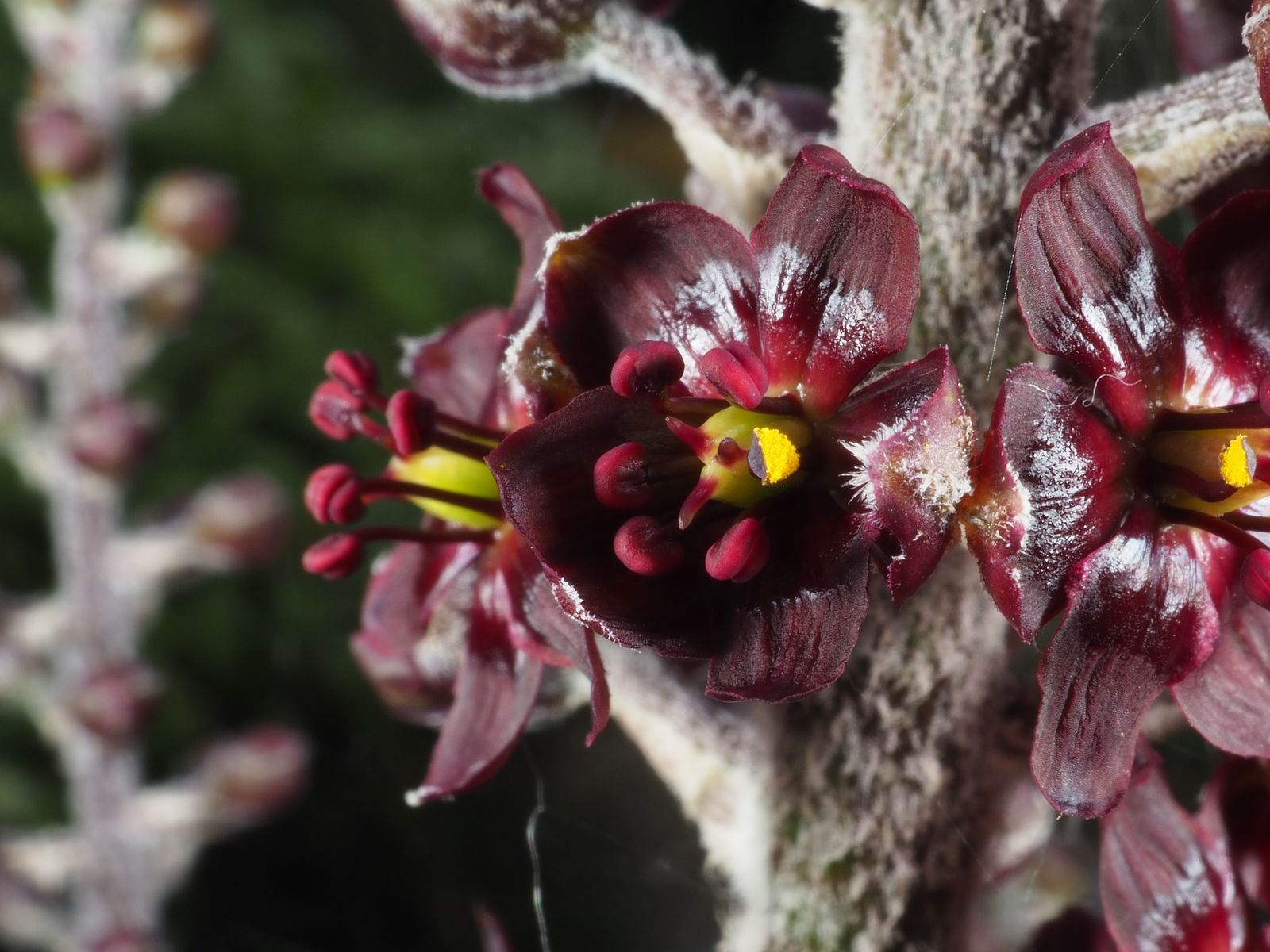Family: Melanthiaceae
Author: L.
Bibliography: Sp. Pl.: 1044 (1753)
Year: 1753
Status: accepted
Rank: species
Genus: Veratrum
Vegetable: False
Observations: C. Europe to Korea
Description
Black veratrum, known scientifically as Veratrum nigrum, is a perennial plant belonging to the Melanthiaceae family. This striking species was first cataloged by the renowned botanist Carl Linnaeus in 1753 in his seminal work, “Species Plantarum”. Found primarily across central Europe, extending its reach all the way to Korea, Black veratrum is celebrated for its hardy nature and distinctive appearance.
This plant typically thrives in damp habitats, favoring the rich, moist soils of meadows, forest edges, and stream banks. Its habitat preferences contribute to its widespread distribution across diverse geographical regions, enabling it to flourish in various climates and altitudes.
A key characteristic of Veratrum nigrum is its tall, graceful stalk, which can reach impressive heights. The plant sports broad, ovate leaves arranged in a lush, basal rosette. From this leafy base rises a sturdy stem, crowned by dense, eye-catching panicles of small, star-shaped flowers. Blooming in mid to late summer, these flowers are strikingly dark, ranging in color from deep purple to nearly black, providing a dramatic contrast to the surrounding greenery.
Despite its beauty, Black veratrum is a plant to be admired from a distance due to its highly toxic nature. All parts of the plant contain potent alkaloids, which can be harmful if ingested. Historically, these toxic properties have seen the plant used in traditional medicine, albeit with great caution given its powerful effects.
In horticultural settings, Veratrum nigrum is appreciated for its ornamental value. Its dark flowers add a unique visual element to garden beds and naturalized areas. Gardeners cultivating this plant will find it prefers partial to full shade and consistently moist soil conditions. When appropriately placed, Black veratrum can bring an air of mystery and elegance to temperate gardens.
In conclusion, the Black veratrum stands out not only for its botanical interest and geographical distribution but also for the striking beauty it lends to natural landscapes and cultivated spaces. With careful handling due to its toxic nature, it remains a fascinating subject of both historical and horticultural significance.
Common Names
Eng: black veratrum, black-hellebore, false hellebore
Deu: schwarzer germer
Swe: svart nysrot
Ita: veratro nero
Fra: vérâtre noir
Nno: mørk nyserot
Nob: mørk nyserot
En: Black veratrum, Black-hellebore, Black false hellebore, False hellebore, False-hellebore
Bg: Черна чемерика
Ca: Hellèbor negre fals
Zh: 藜芦
Hr: Crna čemerika
Cs: Kýchavice černá
Nl: Zwarte nieswortel
Fi: Tummapärskäjuuri
Fr: Vérâtre noir, Vératre noir
De: Schwarzer Germer
Hu: Fekete zászpa
It: Veratro nero
Nb: Mørk nyserot
Nn: Mørk nyserot
Fa: وراتروم نیگروم
Pl: Ciemiężyca czarna
Ru: Чемерица чёрная
Es: Črna čmerika
Sv: Svart nysrot
Zh-tw: 藜蘆
Synonyms
- Veratrum ussuriense ((O.Loes.) Nakai)
- Veratrum purpureum (Salisb.)
- Veratrum nigrum subsp. ussuriense ((O.Loes.) Vorosch.)
- Veratrum nigrum var. microcarpum (Loes.)
- Melanthium nigrum ((L.) Thunb.)
- Veratrum bracteatum (Batalin)
- Veratrum nigrum var. ussuriense (O.Loes.)
- Helonias nigra ((L.) Ker Gawl.)
Distribution
- Albania (native)
- Altay (native)
- Amur (native)
- Austria (native)
- Belarus (native)
- Bulgaria (native)
- Buryatiya (native)
- Central European Rus (native)
- China North-Central (native)
- China South-Central (native)
- Chita (native)
- Czechoslovakia (native)
- France (native)
- Greece (native)
- Hungary (native)
- Inner Mongolia (native)
- Irkutsk (native)
- Italy (native)
- Kazakhstan (native)
- Khabarovsk (native)
- Korea (native)
- Krasnoyarsk (native)
- Manchuria (native)
- Mongolia (native)
- Poland (native)
- Primorye (native)
- Romania (native)
- Switzerland (native)
- Tuva (native)
- Ukraine (native)
- West Siberia (native)
- Yugoslavia (native)
Additional Images

© copyright of the Board of Trustees of the Royal Botanic Gardens, Kew.

© copyright of the Board of Trustees of the Royal Botanic Gardens, Kew.

© copyright of the Board of Trustees of the Royal Botanic Gardens, Kew.
Leaf
Taken Aug 6, 2020 by H Ed (cc-by-sa)
Taken Aug 10, 2022 by Bernard Sudan (cc-by-sa)
Taken Apr 3, 2022 by Paul Davies (cc-by-sa)
Taken Apr 20, 2020 by Lenka Howg (cc-by-sa)
Taken Aug 16, 2022 by Georg Jurceka (cc-by-sa)
Bark
Taken Sep 6, 2022 by Dieter Albrecht (cc-by-sa)
Taken Sep 4, 2022 by Caw Vus (cc-by-sa)
Taken Jul 15, 2018 by Photoflora – Benoit BOCK (©)
Habit
Taken Jul 28, 2020 by uakari (cc-by-sa)
Taken Aug 3, 2021 by Ágnes Varga (cc-by-sa)
Taken Aug 9, 2021 by Giovanni Scarmoncin (cc-by-sa)
Taken Aug 16, 2022 by Georg Jurceka (cc-by-sa)
Taken Apr 10, 2009 by Tela Botanica − Yoan MARTIN (cc-by-sa)
Flower
Taken Jul 26, 2020 by Marco (cc-by-sa)
Taken Aug 9, 2021 by Giovanni Scarmoncin (cc-by-sa)
Taken Aug 9, 2021 by Giovanni Scarmoncin (cc-by-sa)
Taken Mar 23, 2020 by Guillaume Labeyrie (cc-by-sa)
Taken Jul 24, 2020 by Cullum Jo (cc-by-sa)
Fruit
Taken Aug 30, 2020 by Pol Henry (cc-by-sa)
Taken Sep 19, 2017 by Tela Botanica − Alain Bigou (cc-by-sa)
Taken Sep 19, 2018 by Annemarie Ahrens-Stehle (cc-by-sa)
Taken Aug 16, 2022 by Georg Jurceka (cc-by-sa)
Taken Aug 16, 2022 by Georg Jurceka (cc-by-sa)
Other
Taken Jul 15, 2018 by Photoflora – Benoit BOCK (©)
Taken Aug 15, 2005 by Photoflora – Jean-Luc TASSET (©)
Taken Aug 15, 2018 by Photoflora – Jean-Luc TASSET (©)
Taken Aug 15, 2004 by Photoflora – Jean-Luc TASSET (©)
Taken Jan 1, 1970 by Photoflora – L’Abbé COSTE (©)
Sources
- WFO (No URL)
- IPNI (No URL)
- GBIF (https://www.gbif.org/species/2742096)
- POWO (http://powo.science.kew.org/taxon/urn:lsid:ipni.org:names:543516-1)
- PlantNet (https://identify.plantnet.org/species/the-plant-list/Veratrum nigrum L.)
Specifications
Growth
Bloom months: [‘jul’, ‘aug’]




























